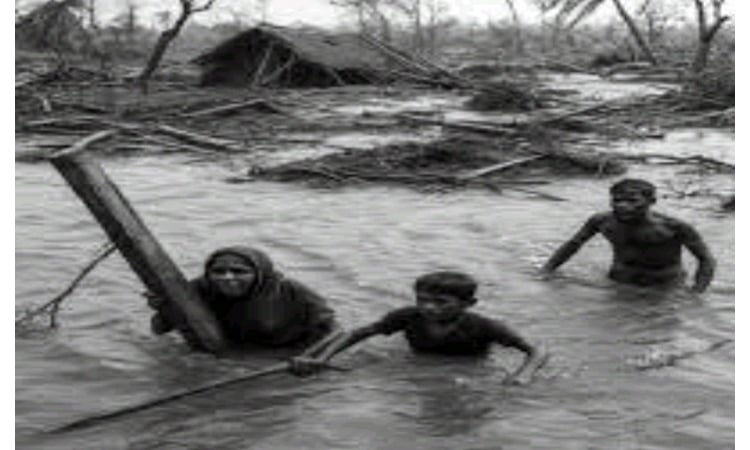News Flash

By Al-Amin Shahriar
BHOLA, Nov 12, 2025 (BSS) - Today marks the anniversary of November 12, 1970, the dreadful night when the catastrophic “Bhola Cyclone”, one of the deadliest storms in the country’s history, ravaged Bangladesh’s coastal belt, leaving behind an indelible scar of loss and resilience.
On November 12, 1970, this catastrophic cyclone also known as the ‘Gorky Cyclone’ turned into a massive storm surge that swept away everything in its path.
The ferocious wind, the violent currents, and lightning from black clouds devastated Bhola and nearby coastal districts. Around one million people lost their lives across the coast, of them, more than one lakh were from Bhola alone.
According to reports, the greatest loss of life occurred in the island district of Bhola, 48.01 KM away from Barisal town, and the coastal areas of Noakhali, including Ramgati, Hatiya, and Sandwip, as well as parts of Patuakhali.
The mighty rivers - the Meghna, Tentulia, and Kalabador- were filled with the bodies of storm victims. That tragic night is forever remembered as a dark and heartbreaking night in coastal area’s history.
According to the World Meteorological Organization (WMO) of the United Nations, the “Bhola Cyclone” was one of the deadliest cyclones in the world history.
Even today, coastal residents shudder when recalling the horrors of that night. Survivors still bear the emotional scars of that sudden and merciless disaster. The cyclone, which struck the then–East Pakistan’s southern region, remains the most catastrophic natural disaster ever recorded. Official reports estimated 500,000 deaths, while unofficial counts put the number at over one million.
It was the sixth and strongest cyclone of the 1970 North Indian Ocean cyclone season, classified as a Category-3 storm on the Simpson Scale. With storm surges 15–25 feet high, it flooded and obliterated entire coastal areas and islands.
Those who survived or lost loved ones can still feel the pain of that night.
Recalling the event, centenarian journalist M. Abu Taher, editor of weekly Dwikontho of Bhola, said: “That dreadful day in Daulatkhan’s Chowkighat, I saw snakes and humans tangled together. A mother lay dead on the Meghna’s bank, her child still in her arms. Without shrouds, bodies were wrapped in banana leaves or sackcloth for burial. Sometimes many were buried in a single grave.”
“The smell of death filled the air of Bhola. In Manpura, Char Fasson, Lalmohan, Tazumuddin, and Daulatkhan, the corpses of humans and cattle floated away with the tides of the Bay of Bengal.”
He noted that most survivors were men aged 15–49, while half of the victims were children under 10.
Centenarian politician and former Manpura Upazila Chairman Md. Kamal Uddin recalled: “In Char Badam, Char Sita, and Char Jobbar, I saw countless bodies scattered across the paddy fields, their faces covered with salt water. The dead lay in rows — humans and livestock alike. Ramgati, Hatiya, Sandwip, Bhola, and Patuakhali became fields of destruction.”
Journalist Zahidul Islam, a member of the Bhola Press Club, said: “The storm surge took away my mother and family. Every year, when this day comes, I am overwhelmed with grief.”
The cyclone formed as a low-pressure over the southeastern Bay of Bengal on November 8, 1970. Feeding on warm sea temperatures, it intensified into a severe cyclone by November 11 with winds reaching 185–240 km/h.
On November 12 evening, it struck Bhola, Patuakhali, Barishal, and Chattogram, with wind speed around 185–224 km/h. The most catastrophic element was the storm surge, reaching 10 meters (over 30 feet) high, which engulfed entire villages and fields overnight while most residents slept, leaving no chance to flee.
People tied themselves to trees, climbed onto rooftops or boats in desperation, but the surge swallowed everything — humans, animals, crops. Survivors floated in freezing water for hours, wounded and hungry.
By dawn on November 13, the cyclone weakened after crossing land leaving behind an unimaginable trail of death and destruction — one of the worst natural disasters in global history.
Following the disaster, Maulana Abdul Hamid Khan Bhashani, the leader of the oppressed, visited Bhola with government officials to witness the devastation. Deeply moved, he appealed to international donor agencies for humanitarian assistance.
The World Meteorological Organization (WMO) later confirmed that the 1970 Bhola Cyclone remains the deadliest tropical cyclone ever recorded, with sustained winds of 185 km/h during landfall.
Marking the anniversary of the devastating cyclone, doa mahfil and discussions were held across Bhola today.
Various voluntary and youth organizations including Upakul Foundation, B-Dwip Forum, Red Crescent Youth, Volunteers for Bangladesh, Jubo Shakti Chhatra Kalyan, Jubo Shakti Foundation, B-Dwip Chhatra Kalyan Sangsad, Paribartan Jubo Unnayan Sangstha, Bangladesh Volunteer Foundation, Alokito Jibon Chhatra Songathan, Volunteers Forum Bangladesh, Youth Network for Development, and Manobotar Bondhon Jubo Unnayan Sangstha and Mostafa Chairman Smriti Sangha have arranged commemorative programmes and discussions on cyclone preparedness.
A special remembrance event and discussion was held at Bhola Press Club this morning on the occasion. Bhola District BNP convener Golam Nabi Alamgir spoke as the chief guest with Convener of the Press Club Advocate Amirul Islam Baset in the chair.